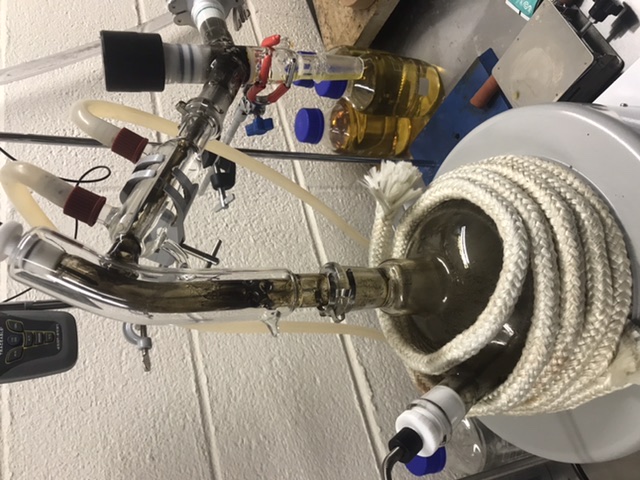We were shutting down a SPD second pass. Mantle was off, but still at around 220 with very little tails left. I turned of the vacuum pump and unplugged it. When I left vacuum back in to the system a pop was heard with a small explosion in the boiling flask and it caught other things on fire. This is what the SPD looked like. What would cause this? 
Potentially solvent trapped where ever you let vacuum back into the system at. Solvent got sucked into the system. Solvent hit it’s flash point & ingnites
Looks like one for MSPGA
What’s MSPGA?
Did you leave the whole thing assembled when you turned it off and let it sit
@DocMolecule i think is right on this one. But we can check. But first
You don’t have a cold trap before the pump?
What kind of pump you have?
Did you check for chips and micro cracks of the glass before usage?
Clean out your pump also
The only two kinda possibilities would be an implosion or heating element malfunction.
A micro/nano crack or chip can cause an implosion. So double check your glass for these signs when you dismantle it. But if that panic moment was an “ole shit we throwing this mf on the ground away from everything and contain it down there’” than this way is out if the question but the next scenario could be found out.
A heating element safety temperature shut off malfunction. Basically your mantle didn’t turn off or/and your element started rising temps. Remember temperature directly mimics what pressure does. It’s vice versa also. Once vacuum pulled this rapid change process variable it caused an overheated glass/crude to spread rapid fatigue/stress cracks around that BF. We know the crude leaving the mantle is thicker which i woukd imagine insulate the heat better. A pinch point would be on the glass between the heating element and crude. . Also These type of cracks will be more uniformed and would be seen after you clean it off. Time to bust out the microscope and see what it is.
I did not let it sit, I just turned things off and immediately closed the single cow, and pretty rapidly opened the vacuum valve. I had recovered quite a bit of heptane in the cold trap from LLE also. I was lucky it didn’t ignite.
I just looked up heptane auto ignition temperature; 223c. My mantle was at 220c.
I should probably have mentioned that none of the glass fractured.
I usually pull a vac until the system cools a bit
Leaving the vacuum on helps pull heat away from the boiling flask when you’re cooling your system off
Best thing to do IMO to avoid this
Sounds to me like you let atmosphere into the system too rapidly for the quality of glass. It exploded. The resulting fire can be from any number of volatiles remaining in the system.
Especially a quick release of vapor from the cold trap after introducing relatively hot air in a spot that had been cold the entire run.
Just my 2 cents.
If there was a fireball inside the flask then I would guess it auto ignited. Never heard of it happening at such a low temperature but could be due to the fact that it was previously under vacuum and a good amount of vaporized cannabinoids were still present
Always keep the vacuum applied to the system until <140C
I’m not terribly familiar with these systems yet, but upon reading your description my thoughts were similar to what most have said:
You have a low pressure, high temperature environment, and we think there was some solvent vapor present. When you suddenly open the system to atmosphere, air rushes in and hits the low pressure vapor like a hammer. As the vapor is compressed it is rapidly heated, allowing it to auto-ignite.
Just my thoughts!
I keep vac until I’m well below 200c. patience is a virtue.
I did another run yesterday. I let the mantle cool down to 100c under full vacuum, and then I slowly (over 10 minutes) released the vacuum. No ignition. This was a wake up call for us, glad it happened before anyone got hurt.
DIY Polariscope: Glass blower homie taught me this, Ive used this technique in a pinch to give me a lil more assurance than eyesight/magnifyingGlass alone.
“Using a cell phone with a polarized lens as a polariscope, you would put the glass on top of the cellphone with the screen lit up on the phone. That’s your light, your bottom polarizing lens, and your glass to be tested. Rotate whatever you’re using as the second or top lens until it’s dark and you see stress…or not.”
When its under vacuum the mixed boiling points change. When you put atmosphere into the boiling flask the mixed boiling points change again, causing some of the components left in the boiling flask to boil and others to stop boiling. Leave your vacuum on and running until your system has completely cooled.
